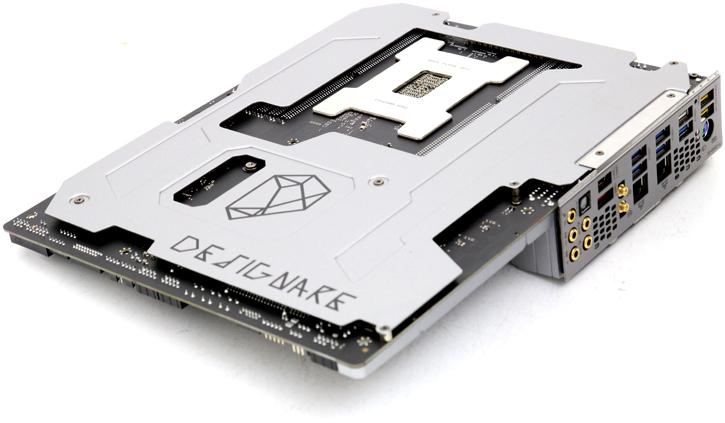Conclusion
Final Words
The new Designare Ex hat Gigabyte offers is a lovely piece of hardware, but features wise very close to the Aorus Gaming 7 with a near similar PCB and component design, but hey that board already was really impressive as well. We had no issues and the performance is often close to the baseline performance. While two Gigabit NICs are lovely, we do once again sorely miss a 5 or 10 Gbps Ethernet jack. Stability and compatibility wise we cannot complain. The G.Skill memory 8GB 3200 CL 14 (which can be found under SKU code F4-3200C14D-16GTZR) was running perfect, just flick your XMP mode in the BIOS and you boot at that 3200 MHz CL14 with nice tight timings into Windows problem free. Then there's a nice selection of storage options ranging from SATA3 towards and triple M2 (all shielded). And then there is stuff like the many x16 PCIe slots and WIFI in the form of AC.
Performance
You have seen the results. Funny story: tests and benchmarks that normally take 5 minutes to finish do that in half or even less the time it usually takes. Many threaded applications will fly in terms of relative performance. And make no mistake, single threaded performance as well is really good as Threadripper can boost towards 4.0 GHz with an extra 200 MHZ XFR allowance as well. You can clock and thus tweak all cores on this proc to 4 GHz as well. Albeit you do need to wonder if that is fair in terms of extra heat levels and power consumption. But sure, if you want to, you could. You probably (and even very likely) do not need a 16-core processor, I have stated it many times already, I feel that we all need to move to 6 and 8-core processors as these simply offer a snappier and faster PC ecosystem with all the things we do simultaneously on a PC these days. But long-term a platform like this might last your many MANY years. You have the performance, the threads and let's not forget the connectivity with the many PCIe Gen 3.0 lanes available.
The Experience
I am also happy to report that, with this BIOS and motherboard we really did not run into any significant issues if at all. The memory compatibility and stability is good. If you pick your memory right, you will not have any issues with the Initial Ryzen releases already have removed the launch issues. In the BIOS simply enable the XMP SPD profile and you'll boot straight into Windows with your new timings and frequency. I've mentioned it a couple of times already, but please read up in this article for some good memory recommendations. These memories work on Ryzen and will work just as well on Threadripper as well. Game performance then, it's fine. Yes, you'll be able to perhaps gain 10% more perf at 1080p in a CPU bound situation from a faster clocked Intel counter-part. How important that is to you is totally up to you. My advice, take the money you save on the AMD platform and invest that in a faster GPU. That's what call a double whammy. Think about it. Stability then, no problems whatsoever. The PC boots at XMP into windows instantly, we didn't have a single crash or weird instability whatsoever.
The Memory
The latest BIOSes have improved a lot, Threadripper and 3200 MHz CL14 memory is a non-issue with the right memory, we recommend 2933 MHz or better when you build a gaming rig. Obviously, with quad-channel, you could go a little slower as you gain more bandwidth. All previously AGESA 1006 and newer firmware approved memories as we have tested should be fine to us. It is, however, a new platform and chipset, hence please do give AMD and their motherboard partners a little time to iron out any inevitable bugs and launch issues (but we haven't run into anything significant enough really).
The Power
This processor now fabbed at 14 nm FinFET the TDP sticks to roughly 180 Watts. A full PC at idle will sit in the ~90 Watt range with a dedicated graphics card installed (GeForce GTX 1080 / 16 GB memory / SSD and the motherboard). When we stressed the processors with a Prime 1024M run we reached roughly 260 Watts, that's low enough for what it needs to be. Overall though, this is impressive to see with sixteen CPU cores, especially compared to what we have seen from Intel more recently. When we game we hover at 320~330 Watts which is higher then we are used to, but that's the 2nd CPU die, also and obviously that factor is dependant on the type of graphics card you use of course as well as how many CPU cores the game utilizes. So yeah, these are a notch higher, but overall good enough values with this mega-core Threadripper product series.
The Tweak
Anything Ryzen architecture based does to roughly a max of 4 GHz, but will also end there with an all core tweak. This is the same for Threadripper. Apply a 40x multiplier. Use a voltage offset that gets you close or just at 1.35 volts and you should be able to rock and roll. Be advised though, tweaking creates more heat and thus make sure you have enough cooling. We surely recommend some form of liquid cooling. On the cooling-block / processor surface area coverage we said enough, it's not an issue. None whatsoever. Obviously, tweaking also will increase your power consumption (when the PC is stressed), please do keep that in mind. One note here though, tweaking does remain to be a bit of a conundrum. You can achieve an all core tweak to 4.0 GHz. Intel goes higher in their clocks and often can reach 4.5 to 5 GHz. That's where some residual games perf is found in CPU bound situations. It also would have been nice to see a per core or even per CCX (per 4 cores) tweak. Say four cores at 4200 MHz, four at 4000 MHz and the rest at 3700 MHz. That way you can balance heat and energy consumption better while getting more perf in your main and prioritized threads. The fact that you can clock 16 cores at 4.0 GHz stable at a fairly low voltage, however, is pretty amazing stuff. And that's where we land in the following chapter.
Conclusion
The Designare Ex pretty very nice when it comes to features, realistically it's offering the same as the X399 Aorus Gaming 7 does and that board is 50 bucks cheaper. The looks and design are trivial, it's one of these boards that you do or don't like, styling wise. Personally, the gaming 7 would get my preference, but that is the subjective reasoning. The Designare Ex you receive a nice AC Wireless LAN implementation (super fast as well) but as stated you will miss out on 5/10 Gbps Ethernet, which makes the board a little less future-proof. Connectivity wise in terms of your PCIe slots, well it's all plentiful. Tweaking wise the processor is the limit these days, not your motherboard. See, the mobo board can go higher and will facilitate anything the Threadripper processors can do with up to 3600 MHz clocked on that quad-channel memory as well. However, for TR the domain on all cores is roughly 4.0 ~ 4.1 GHz. One caveat remains X399 pricing - while 399 bucks is a sizable chunk of money, I do say that this board might just be worth it. The build quality is fantastic, the features grand. We can certainly recommend the Designare Ex for what it is, a fun piece of hardware.
ATH +++
- Hilbert out
- Sign up to receive a notice when we publish a new article
- Or go back to Guru3D's front page.
“A mind needs books as a sword needs a whetstone if it is to keep its edge.”



